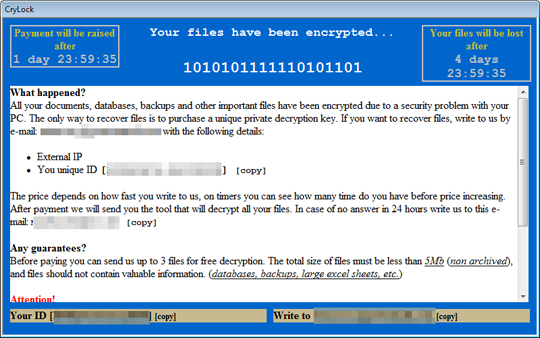Ransom.Win32.CRYLOCK.A
Ransom:Win32/Cryak.PA!MTB(MICROSOFT); Ransom.CryLocker(MALWAREBYTES); Gen:Variant.Ransom.Cryak.55(BITDEFENDER)
Windows


Threat Type: Ransomware
Destructiveness: No
Encrypted:
In the wild: Yes
OVERVIEW
This Ransomware arrives on a system as a file dropped by other malware or as a file downloaded unknowingly by users when visiting malicious sites.
It executes then deletes itself afterward.
It drops files as ransom note. It avoids encrypting files with the following file extensions.
TECHNICAL DETAILS
Arrival Details
This Ransomware arrives on a system as a file dropped by other malware or as a file downloaded unknowingly by users when visiting malicious sites.
Installation
This Ransomware drops the following copies of itself into the affected system:
- %User Temp%\svc{3 random letters}.exe
(Note: %User Temp% is the current user's Temp folder, which is usually C:\Documents and Settings\{user name}\Local Settings\Temp on Windows 2000(32-bit), XP, and Server 2003(32-bit), or C:\Users\{user name}\AppData\Local\Temp on Windows Vista, 7, 8, 8.1, 2008(64-bit), 2012(64-bit) and 10(64-bit).)
It adds the following processes:
- %User Temp%\svc{3 random letters}.exe
- cmd.exe /c "ping 0.0.0.0&del "{malware filepath}\{malware filename}.exe""
- vssadmin.exe delete shadows /all /quiet
- wbadmin.exe DELETE SYSTEMSTATEBACKUP -keepVersions:0
- wbadmin.exe DELETE BACKUP -keepVersions:0
- wbem\WMIC.exe SHADOWCOPY DELETE
- bcdedit.exe /set {default} recoveryenabled No
- bcdedit.exe /set {default} bootstatuspolicy ignoreallfailures
- mshta.exe "%User Temp%\how_to_decrypt.hta"
(Note: %User Temp% is the current user's Temp folder, which is usually C:\Documents and Settings\{user name}\Local Settings\Temp on Windows 2000(32-bit), XP, and Server 2003(32-bit), or C:\Users\{user name}\AppData\Local\Temp on Windows Vista, 7, 8, 8.1, 2008(64-bit), 2012(64-bit) and 10(64-bit).)
It executes then deletes itself afterward.
It adds the following mutexes to ensure that only one of its copies runs at any one time:
- {Generated ID}
Other System Modifications
This Ransomware adds the following registry entries:
HKEY_CURRENT_USER\Software\Microsoft\
Windows\CurrentVersion\Run
{Generated ID} = "%User Temp%\svc{3 random letters}.exe"
HKEY_CURRENT_USER\Software\Microsoft\
Windows\CurrentVersion\Run
{Generated ID}hta = "%User Temp%\how_to_decrypt.hta"
HKEY_LOCAL_MACHINE\SOFTWARE\Microsoft\
Windows\CurrentVersion\Run
{random numbers} = {random numbers}
Other Details
This Ransomware does the following:
- It empties the Recycle Bin
Ransomware Routine
This Ransomware avoids encrypting files with the following strings in their file name:
- how_to_decrypt.hta
- %User Temp%\svc{3 random letters}.exe → its dropped copy
(Note: %User Temp% is the current user's Temp folder, which is usually C:\Documents and Settings\{user name}\Local Settings\Temp on Windows 2000(32-bit), XP, and Server 2003(32-bit), or C:\Users\{user name}\AppData\Local\Temp on Windows Vista, 7, 8, 8.1, 2008(64-bit), 2012(64-bit) and 10(64-bit).)
It avoids encrypting files with the following strings in their file path:
- Windows
- Recycler
It appends the following extension to the file name of the encrypted files:
- [{Malicious Email}][{Generated ID}].{3 random letters}
- where
- {Malicious Email} can be one of the following:
- {BLOCKED}ry@{BLOCKED}ail.com
- {BLOCKED}y@{BLOCKED}.me
- {Generated ID} is unique for every infected machine
- {3 random letters} is different for every encrypted file
- {Malicious Email} can be one of the following:
- where
It drops the following file(s) as ransom note:
- %User Temp%\how_to_decrypt.hta
- {Encrypted Directory}\how_to_decrypt.hta

It avoids encrypting files with the following file extensions:
- .bat
- .bmp
- .dll
- .ini
- .log
- .sys
SOLUTION
Step 1
Trend Micro Predictive Machine Learning detects and blocks malware at the first sign of its existence, before it executes on your system. When enabled, your Trend Micro product detects this malware under the following machine learning name:
-
Troj.Win32.TRX.XXPE50FFF034
Step 2
Before doing any scans, Windows 7, Windows 8, Windows 8.1, and Windows 10 users must disable System Restore to allow full scanning of their computers.
Step 3
Note that not all files, folders, and registry keys and entries are installed on your computer during this malware's/spyware's/grayware's execution. This may be due to incomplete installation or other operating system conditions. If you do not find the same files/folders/registry information, please proceed to the next step.
Step 4
Delete this registry value
Important: Editing the Windows Registry incorrectly can lead to irreversible system malfunction. Please do this step only if you know how or you can ask assistance from your system administrator. Else, check this Microsoft article first before modifying your computer's registry.
- In HKEY_CURRENT_USER\Software\Microsoft\Windows\CurrentVersion\Run
- {Generated ID} = "%User Temp%\svc{3 random letters}.exe"
- {Generated ID} = "%User Temp%\svc{3 random letters}.exe"
- In HKEY_CURRENT_USER\Software\Microsoft\Windows\CurrentVersion\Run
- {Generated ID}hta = "%User Temp%\how_to_decrypt.hta"
- {Generated ID}hta = "%User Temp%\how_to_decrypt.hta"
- In HKEY_LOCAL_MACHINE\SOFTWARE\Microsoft\Windows\CurrentVersion\Run
- {random numbers} = {random numbers}
- {random numbers} = {random numbers}
Step 5
Search and delete this file
- %User Temp%\svc{3 random letters}.exe
- %User Temp%\how_to_decrypt.hta
- {Encrypted Directory}\how_to_decrypt.hta
Step 6
Scan your computer with your Trend Micro product to delete files detected as Ransom.Win32.CRYLOCK.A. If the detected files have already been cleaned, deleted, or quarantined by your Trend Micro product, no further step is required. You may opt to simply delete the quarantined files. Please check the following Trend Micro Support pages for more information:
Step 7
Restore encrypted files from backup.
Did this description help? Tell us how we did.

